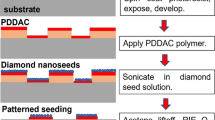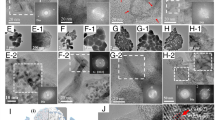Abstract
We used argon and helium gases to dilute silane to deposit silicon thin films by plasma-enhanced chemical vapor deposition (PECVD). Obtained films were characterized by Raman spectroscopy, spectroscopic ellipsometry, and atomic force microcopy (AFM). The three techniques revealed that the films obtained with argon dilution are composed of nanocrystallites embedded in an amorphous matrix. The grain size and the crystalline fraction increases with argon fraction in gas mixture. The optical gap increases from 1.91 to 2.02 eV when the dilution rate varies from 25 to 70%. The refractive index increases also with the dilution rate indicating a more compact film. AFM images show that a smoother surface is obtained with high dilution. All the results obtained from films deposited with helium dilution have the feature of an amorphous phase in contrary of those obtained with argon dilution where a nanocrystalline phase appears. These results show that these two inert gases have different effects on silicon film’s growth kinetic.






Similar content being viewed by others
References
Shah AV, Meier J, Buechel A, Kroll U, Stenhauser J, Meillaud F, Shade H, Domine D (2006) Towards very low-cost mass production of thin-film silicon photovoltaic (PV) solar modules on glass. Thin Solid Films 502:292–299
Orpella A, Voz C, Puigodollers J, Dosev D, Fonrodona M, Soler D, Bertomeu J, Asensi JM, Andreu J, Alcubila R (2001) Stability of hydrogenated nanocrystalline silicon thin-film transistors. Thin Solid Films 395:335–338
Chowdhury A, Mukhopadhyay S, Ray S (2008) Effect of gas flow rates on PECVD-deposited nanocrystalline silicon thin film and solar cell properties. Sol Energy Mater Sol Cells 92:385–392
Meir J, Fluckiger R, Kepprer H, Shah A (1994) Complete microcrystalline p-i-n solar cell—crystalline or amorphous cell behavior. Appl Phys Lett 65:860–862
Staebler DL, Wronski CR (1977) Reversible conductivity changes in discharge-produced amorphous Si. Appl Phys Lett 31:292–294
Zhang S, Liao X, Raniero L, Fortunato E, Xu Y, Kong G, Águas H, Ferreira I, Martins R (2006) Silicon thin films prepared in the transition region and their use in solar cells. Sol Energy Mater Sol Cells 90(18–19):3001–3008
Raniero L, Zhang S, Águas H, Ferreira I, Igreja R, Fortunato E, Martins R (2015) Role of buffer layer on the performances of amorphous silicon solar cells with incorporated nanoparticles produced by plasma enhanced chemical vapor deposition at 27.12 MHz. Thin Solid Films 487(1):170–173
Prashar A, Kumar S, Gope J, Rauthan CMS, Dixit PN, Hashmi DA (2010) Influence of argon dilution on growth properties of hydrogenated nanocrystalline silicon films. Sol Energy Mater Sol Cells 94:892–899
Bhattacharya K, Das D (2007) Nanocrystalline silicon films prepared from silane plasma in RF-PECVD using helium dilution without hydrogen:structural and optical characterization. Nanotechnology 18:415704–415713
Matsuda A (1983) Formation kinetics and control of microcrystallite in μc-Si:H from glow discharge plasma. J Non Cryst Solid 59–60:767–774
Saito N, Sannomiya H, Yamaguchi T, Tanaka N (1984) Dependence of properties of hydrogenated microcrystalline and amorphous silicon films prepared by planar magnetron sputtering in inert gas. Appl Phys 35:241–247
Maniv S, Westwood WD (1980) Effect of H2 on an argon discharge for planar magnetron sputtering. J Vac Sci Technol 17:403–406
Hossain M, Abu-Safe HH, Naseen H, Brown WD (2006) Characterization of hydrogenated amorphous silicon thin films prepared by magnetron sputtering. J Non Cryst Solids 352:18–23
Das D (2003) A novel appraoch towards silicon nanotechnology. J Phys D Appl Phys 36:2335–2346
Kim IK, Lim JH, Yeom GY (2011) Characteristics of hydrogenated silicon thin deposited by RF-PECVD using He-SiH4 misxture. Vaccum 86:82–86
Gope J, Kumar S, Sudhakar S, Lodhi K, Rauthan CMS, Srivastava PC (2013) Influence of argon dilution on the growth of amorphous to ultra nanocrystalline silicon films using VHF PECVD process. J Alloys Comp 577:710–716
Saadane O, Lebib S, Kharchenko AV, Longeaud C, Roca i Cabarrocas R (2003) Structural, optical and electronic properties of hydrogenated polymorphous silicon films depsoited from silane–hydrogen and silane helium mixture. J App Phys 93:9371–9379
Torres I, Barrio R, Santos JD, Gonzalez N, Gandia JJ (2010) Effect of radio frequency power and total mass-flow rate on the properties of microcrystalline silicon films prepared by helium diluted silane glow discharge. Thin Solid Films 518:7019–7023
Zhang S, Raniero L, Pereira L, Martins N, Canhola P, Ferreira I, Águas H, Fortunato E, Martins R (2004) The characterization of silicon carbide thin films prepared by VHF PECVD technology. J Non-Crist Solids 338–340:530–533
Waman VS, Kamble MM, Ghosh SS, Hawaldar RR, Amalnekar DP, Sathe VG, Gosavi SW, Jadkar SR (2012) Influence of helium dilution of silane on microstructure and opto-electricam preperties of hydrogentaed nanocrystalline silicon (nc-Si:H) thin films deposited by HWCVD. Mater Res Bull 47:3445–3451
Pi XD, Gresback R, Liptak RW, Campbell SA, Kortshagen U (2008) Doping efficiency, dopant location, and oxidation of Si nanocrystals. Appl Phys Lett 92:123102
Gope J, Kumar S, Sudhakar S, Lodhi K, Rauthan CMS, Srivastava PC (2013) Influence of argon dilution on the growth of amorphous to ultra nanocrystalline silicon films using VHF PECVD process. J Alloy Compd 577:710–716
Bakr NA, Mubarak TH, Habubi NF (2013) Impact of dilution gases on structure, properties and growth of hydrogenated nanocrystalline silicon (nc-Si:H) prepared by HW-CVD method. Int J Thin Film Sci Technol 2:113–126
Bakr NA (2012) Helium induced structural disorder in hydrogenated nanocrystalline silicon (nc-Si:H) thin films prepared by HW-CVD Method. J Nano Elcetron Phys 4:03006
Basker NA, Funde AM, Waman VS, Kamble MM, Hawaldar RR, Amalnerkar DP, Sathe VG, Gosavi SW, Jadkar SR (2011) Role of argon in hot wire chemical vapor deposition of hydrogenated nanocrystalline silicon thin films. Thin Solid Films 519:3501–3508
Tchalarov S, Das D, Saadane O, Kharchenko AV, Suendo V, Kail F, Cabarrocas PR (2004) Helium versus hydrogen dilution in the optimization of polymorphous silicon solar cells. J Non Cryst Solids 668:338–340
Middya AR, Hazar S, Ray S (1994) Growth of device quality amorphous SiGe:H alloys with high deposition rate under helium dilution. J Appl Phys 76:7578
Bhattacharya K, Das D (2008) Nanocrystalline silicon prepared at high growth rate using helium dilution. Bull Mater Sci 31:467–471
Voutsaa AT, Hatilis MK, Boyce J (1995) Raman spectroscopy of amorphous and microcrystalline silicon films deposited by low-pressure chemical vapor deposition. J Appl Phys 78:6999 12p
Iqbal Z, Vepreck S (1982) J Phys C Solid State Phys 15:377
He Y, Yin C, Cheng G, Wang L, Liu X, Hu GH (1994) The structure and properties of nanosize crystalline silicon films. J Appl Phys 75:797–803
Kole A, Chaudhuri P (2014) Growth of silicon quantum dots by oxidation of the silicon nanocrystals embedded within silicon carbide matrix. AIP Adv 4:107106
Kushner MJ (1988) A model for the discharge kinetics and plasma chemistry during plasma enhanced chemical vapor deposition of amorphous silicon. J Appl Phys 63:2532
Das UK, Chaudhuri P, Kshirsagar ST (1996) Effect of argon dilution on the structure of microcrystalline silicon deposited from silane. J Appl Phys 80:5389 9 pp
Rui Xu, Li Wei, He Jian, Sun Yan, Jiang Ya-Dong (2013) Investigation of nanocrystallisation of a-Si1-xGex: H thin films diluted with argon in the PECVD system. J Non Cryst Solids 365:37–41
Chaudhuri P, Meaudre R, Longeaud C (2004) Argon dilution of silane as an alternative to hydrogen dilution for stable and high efficiency silicon thin films solar cells. J Non Cryst Solids 338–340:690–693
Roca i Cabarrocas P, Fontcuberta i Morral A, Poissant Y (2002) Growth and optoelectronic properties of polymorphous silicon thin films. Thin Solid Films 403-404:39–46
Losurdo M, Giangregorio MM, Sacchetti A, Capezzuto P, Bruno G, Moriucci L, Fortunato G (2007) Insight into excimer laser crystallization exmloiting ellipsometry: effect of silicon film precursor. Thin Solid Films 515:7508–7512
Losurdo M, Rizzoli R, Summonte C, Cicala G, Capezzuto P, Bruno G, Mariucci L, Fortunato G (2000) Anatomy of mc-Si thin films by plasma enhanced chemical vapor deposition: an investigation by spectroscopic ellipsometry. J Appl Phys 88:2408–2414
Goswami R, Ray S (2013) Structural studies on Si:H network before and after solid phase crystallization using spectroscopic ellipsometry: correlation with Raman spectroscopy and transmission electron microscopy. Appl Surf Sci 282:615–623
Amrani R, Abboud P, Chahed L, Cuminal Y (2012) Low temperature growth of hydrogenated silicon prepared by PECVD from argon diluted silane plasma. Cryst Struct Theory Appl 1:62–67
Wang YH, Lin J, Huan CHA (2003) Structural and optical properties of a-Si:H/nc-Si:H thin films grown from Ar–H2–SiH4 mixture by plasma-enhanced chemical vapor deposition. Mater Sci Eng, B 104:80–87
Waman VS, Funde AM, Kamble MM, Pramod MR, Hawaldar RR, Amalnerkar DP, Sathe VG, Gosavi SW, Jadkar SR (2011) Hydrogenated nanocrystalline silicon thin films prepared by hot-wire method with varied process pressure. J Nanotechnol 2011 (2011), Article ID 242398
Lie W, Xia D, Wang H, Zhao X (2010) Hydrogenated nanocrystalline silicon thin films prepared by RF-PECVD at high pressure. J Non Cryst Solids 356:2552–2556
Mahan AH, Biswas R, Gedvilas LM, Williamson DL, Pan BC (2004) On the influence of short and medium range order on the material band gap in hydrogenated amorphous silicon. J Appl Phys 97:3818–3826
Yan B, Yue G, Yang J, Guba S (2013) On the band gap of hydrogenated nanocrystalline silicon intrinsic materials used in thin film silicon solar cells. Sol Energy Mater Sol Cells 111:90–96
Amor SB, Bousbih R, Ouertani R, Dimassi W, Ezzaouia H (2014) Correlation between microstructure and properties of hydrogenated Si thin films grown by plasma enhanced chemical vapor deposition under different hydrogen flow rates. Sol Energy 103:12–18
Ledinsky M, Fekete L, Stuchlik J, Mates T, Fejfar A, Kocka J (2006) Characterisation of mixed phase silicon by Raman spectroscopy. J Non Cryst Solids 352:1209–1212
Acknowledgements
This work is funded by FEDER funds through the COMPETE 2020 Program and National Funds through FCT - Portuguese Foundation for Science and Technology under the Project Number POCI-01-0145-FEDER-007688, Reference UID/CTM/50025/2013, by the Tunisian Ministry of High Education and Scientific Research and by the bilateral cooperation project FCT/5962/27/5/2013/S.
Author information
Authors and Affiliations
Corresponding author
Rights and permissions
About this article
Cite this article
Chaibi, F., Jemai, R., Aguas, H. et al. The effects of argon and helium dilution in the growth of nc-Si:H thin films by plasma-enhanced chemical vapor deposition. J Mater Sci 53, 3672–3681 (2018). https://doi.org/10.1007/s10853-017-1791-1
Received:
Accepted:
Published:
Issue Date:
DOI: https://doi.org/10.1007/s10853-017-1791-1




